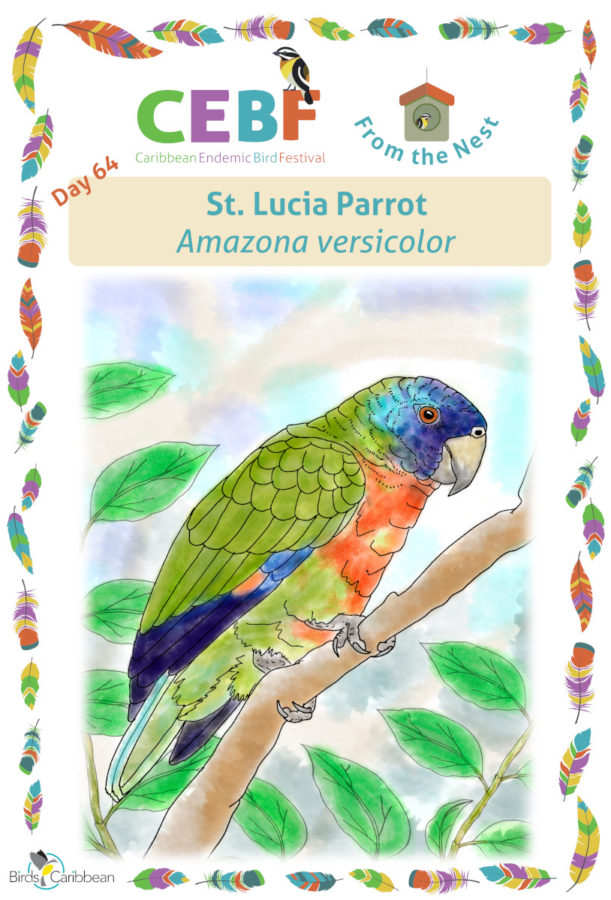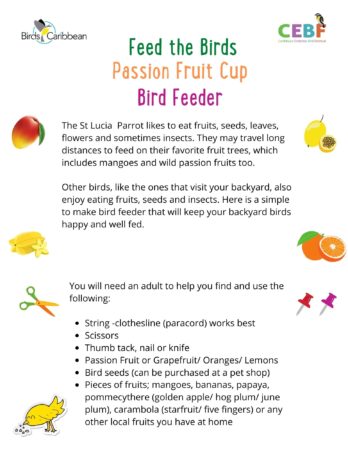Celebrate the Caribbean Endemic Bird Festival (CEBF) with us! Our theme in 2021 is “Sing, Fly, Soar—Like a Bird!” Have fun learning about a new endemic bird every day. We have colouring pages, puzzles, activities, and more. Download for free and enjoy nature with your family at home.
Endemic Bird of the Day: St. Lucia Parrot
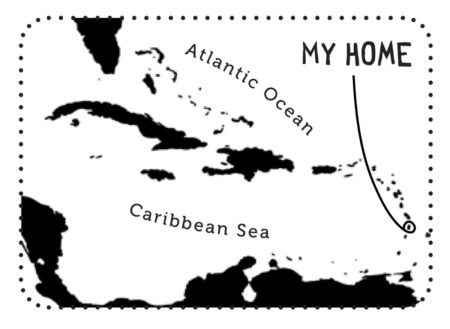 The St. Lucia Parrot is the national bird of St. Lucia. Affectionately known locally as “Jacquot,” it is the best known St. Lucian endemic bird species. At 18 inches, it is also one of the largest birds in St. Lucia. Its plumage is mostly iridescent green, with patches of bright red, black, white, yellow, and blue. The vivid cobalt blue to purple on the head and scarlet breast are striking characteristics of the Jacquot. The St Lucia Parrot is one of the most colourful of the entire genus of Amazona parrots, hence the species name versicolor.
The St. Lucia Parrot is the national bird of St. Lucia. Affectionately known locally as “Jacquot,” it is the best known St. Lucian endemic bird species. At 18 inches, it is also one of the largest birds in St. Lucia. Its plumage is mostly iridescent green, with patches of bright red, black, white, yellow, and blue. The vivid cobalt blue to purple on the head and scarlet breast are striking characteristics of the Jacquot. The St Lucia Parrot is one of the most colourful of the entire genus of Amazona parrots, hence the species name versicolor.
Many years ago the St. Lucia Parrot was in grave danger of becoming extinct. Its population was estimated at only ~150 birds in 1976 due to years of hunting, habitat destruction, and the illegal bird trade. Now, there are about 2,000 parrots flying, feeding, roosting, and nesting in various forested areas in St. Lucia.
There are several reasons why the parrot population rebounded so successfully. In 1978, in partnership with Paul Butler of Rare, the Forestry Dept launched a campaign to save the species from extinction. In 1979, the parrot was made the National Bird of St. Lucia. In 1980, wildlife legislation was revised, making the parrot and other forms of wildlife absolutely protected year-round. Anyone found hunting, keeping, or trying to trade in these birds is liable to a fine of $5,000 or one year in jail. In addition, Forestry laws were also revised to protect watersheds as well as wildlife habitats. Illegal clearing of forest is punishable by fines of $2,000.
Finally a Pride Campaign—an island-wide education program about the unique value and beauty of the bird— was carried out. Schoolchildren and the public learned about the parrot through a parrot mascot “Jacquot,” songs on the radio, billboards, bumper stickers, stamps, hats, t-shirts, posters, and more. Gradually, St. Lucians embraced the parrot as a national treasure. This landmark campaign and other actions reduced the incidence of deforestation, hunting, and other illicit activities in the forest reserves to near zero, thus helping to ensure the long-term survival of this amazing endemic bird.
The parrot’s habitat is primarily moist forest in the interior mountain range; it can also occur in secondary forest and cultivated areas. Despite their large size and bright plumage they can be difficult to see in the dense forest canopy as they clamber about in search of fruits, nuts, seeds, and berries from a wide variety of trees including Gommier, Chatagnier, Bois Pain Maron and Aralie. They may travel considerable distances to feed on their favorite fruit trees, which includes awali, mangoes, and wild passion fruits.
St. Lucia Parrots nest in cavities in tall Gommiere, Chataniere, and other trees, where they lay two and occasionally three white eggs. Breeding occurs mainly from February to May, sometimes in June and July.
Did you know that parrots usually mate for life? If one of the pair dies or is killed it may be years before the survivor finds another mate. Parrots do not sing. They fly to their feeding grounds early in the morning and return home late in the afternoon. As they fly, their loud screeching calls echo through the forest, making them easy to identify. Learn more about this species, including its range, photos, and calls here.
Colour in the St. Lucia Parrot
Download our West Indies Endemic Bird colouring page. Use the photos below as your guide, or you can look up pictures of the bird online or in a bird field guide if you have one. Share your coloured-in page with us by posting it online and tagging us @BirdsCaribbean #CEBFfromthenest
Listen to the calls of the St. Lucia Parrot
The calls of the St. Lucia Parrot are a loud, squawking “ka-chuck and plaintive “ay-uh.”
Puzzle of the Day
Click on the image below to do the puzzle. You can make the puzzle as easy or as hard as you like – for example, 6, 8, or 12 pieces for young children, all the way up to 1,024 pieces for those that are up for a challenge!
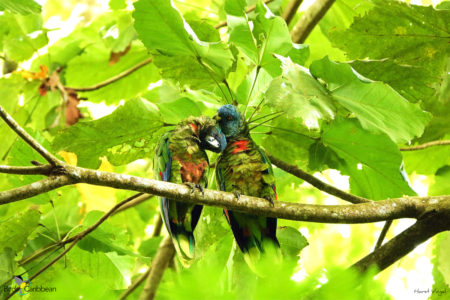
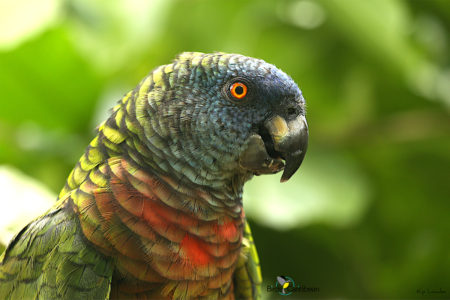
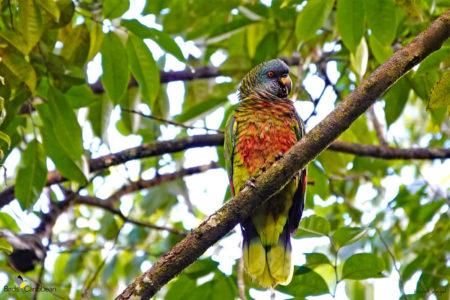
Activity of the Day
FOR KIDS AND ADULTS: St. Lucia Parrots love to eat fruits and seeds! Why not try making this passion fruit cup feeder? You can can fill it with seeds or pieces of fruit, and hang in your garden to keep the parrots well fed. Not in St. Lucia – the home of these beautiful endemic parrots? No problem, any parrots that live near you and many other types of wild birds, will love this feeder! Hang it out, fill it with food and see who comes to visit for lunch. Remember that this activity involves using scissors and knife, you will need an adult to help with making this.
Even if you don’t get any parrot visitors to you feeder you can enjoy this video of St. Lucia Parrots in the wild! The video shows a pair or parrots feeding on some palm fruits.
Find out more about the St. Lucia Parrot in this fun and creative St. Lucia Parrot zine! If you enjoy reading this zine and feel inspired, why not enter our Caribbean endemic bird zine competition? Just like the example here, a zine is a self-published booklet. Zines tend to be a collage of different images, text, and messages put together by writing, drawing, and/or cutting and gluing content into a booklet. You will find detailed guidelines and judging criteria in these docs: Bird Zine Contest Guidelines and What is a Zine and Bird Zine Contest Instructions. Be sure to read both documents carefully. There are prizes for each age category and two awesome GRAND PRIZES of a pair of waterproof Vortex Optics Binoculars! The new deadline for entries is Sunday May 30th!

